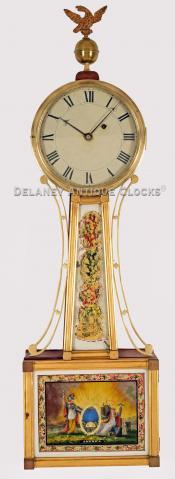Aaron Willard Jr., of Boston, Massachusetts. A gilt frame wall timepiece or banjo clock. 219013.
This outstanding Federal Massachusetts Timepiece, or "Banjo clock," was made by Aaron Willard Jr. of Boston, Massachusetts, circa 1825.
The case is constructed in mahogany and features mahogany frames that retain their original gilding. The gilding remains in excellent original condition. The frames are fitted with reverse painted or eglomise decorated tablets that are also in excellent original condition. These exhibit a very high level of artistic skill. The detail work, enhanced by the vibrant colors, is outstanding. The lower tablet is titled "America" in a banner below the scene. Depicted on the left is Minerva, the Goddess of Wisdom. She is poised with her left arm outstretched and down towards the oval opening, allowing one to view the motion of the brass-faced pendulum bob that swings behind the glass. Here, the sun is rising into the sky. To the right is a seated woman of classic beauty. She is depicted with a headdress, a long flowing dress, and a cap. This figure is known to historians as "The Plumed Goddess" or, more commonly called today, "The Genius of America." She becomes a representation of the Union celebrating its independence and the expression of the newly formed Republics' optimism of this new country. She is holding Mercury's staff and sitting on several American goods traded long distances. The ship in the background reinforces this thought. The goods include bails of cotton, tobacco, and other commodities. This scene is set against the morning sky of a bright new day. The sun's radiants reached the heavens. The throat tablet is decorated with a traditional theme. The colors complement those used on the lower tablet. The sidearms, finial, and dial bezel are brass. The dial bezel is fitted with glass and opens to a painted iron dial. This dial features a traditional time ring formatted with Roman hour numerals. The time is indicated by wonderfully hand-filed steel hands—a trait of most Aaron Willard wall clocks.
The time-only movement is weight-driven and designed to run for eight days on a full wind. Please note that the original time weight descends a channel in the center of the case directly below the works. This channel is framed in pine. The movement features brass construction. The two brass rectangular plates frame the gearing and are secured by four brass pillars. You will also notice the "A. WILLARD JR / BOSTON" die-stamp in the upper left corner. As is the tradition of a repairman of the period, the front plate bears several fascinating date engravings. These serve as a record of the clocks' being serviced over the years. The movement is mounted to the backboard with two thru-bolt screws that are diagonally positioned on the plates. They secure the backplate to the wooden backboard. The pendulum is supported by a bridge suspension post. Overall, the movement is of excellent quality, typical of this Maker. The pendulum is constructed with a steel rod and a brass-faced lead bob. The brass face is, of course, visible through the lower opening in the front door. This motion indicates that the clock is operating.
This attractive clock, with its unique naval battle depiction and excellent original condition, measures approximately 34.5 inches long to the top of the finial and was made around 1820.
Inventory number 219013.
Aaron Willard Jr. was born in Roxbury, Massachusetts, on June 29, 1783. He had the good fortune of being born into America's leading clockmaking family. His father, Aaron, and uncle Simon had recently moved from the rural community of Grafton and began a productive career manufacturing high-quality clocks in this new ideal location. Based on the traditions of the day, it is thought that Aaron Jr. probably learned the skill of clockmaking from his family. We have owned a large number of wall timepieces or more commonly called banjo clocks, that this talented maker made. Based on the numbers seen in the marketplace, it is logical to assume he was one of the most prolific makers of this form. We have also owned a fair number of tall case clocks, Massachusetts shelf clocks, and gallery clocks. Aaron Jr. retired from clockmaking sometime around 1850 and moved to Newton, Massachusetts. He died on May 2, 1864








